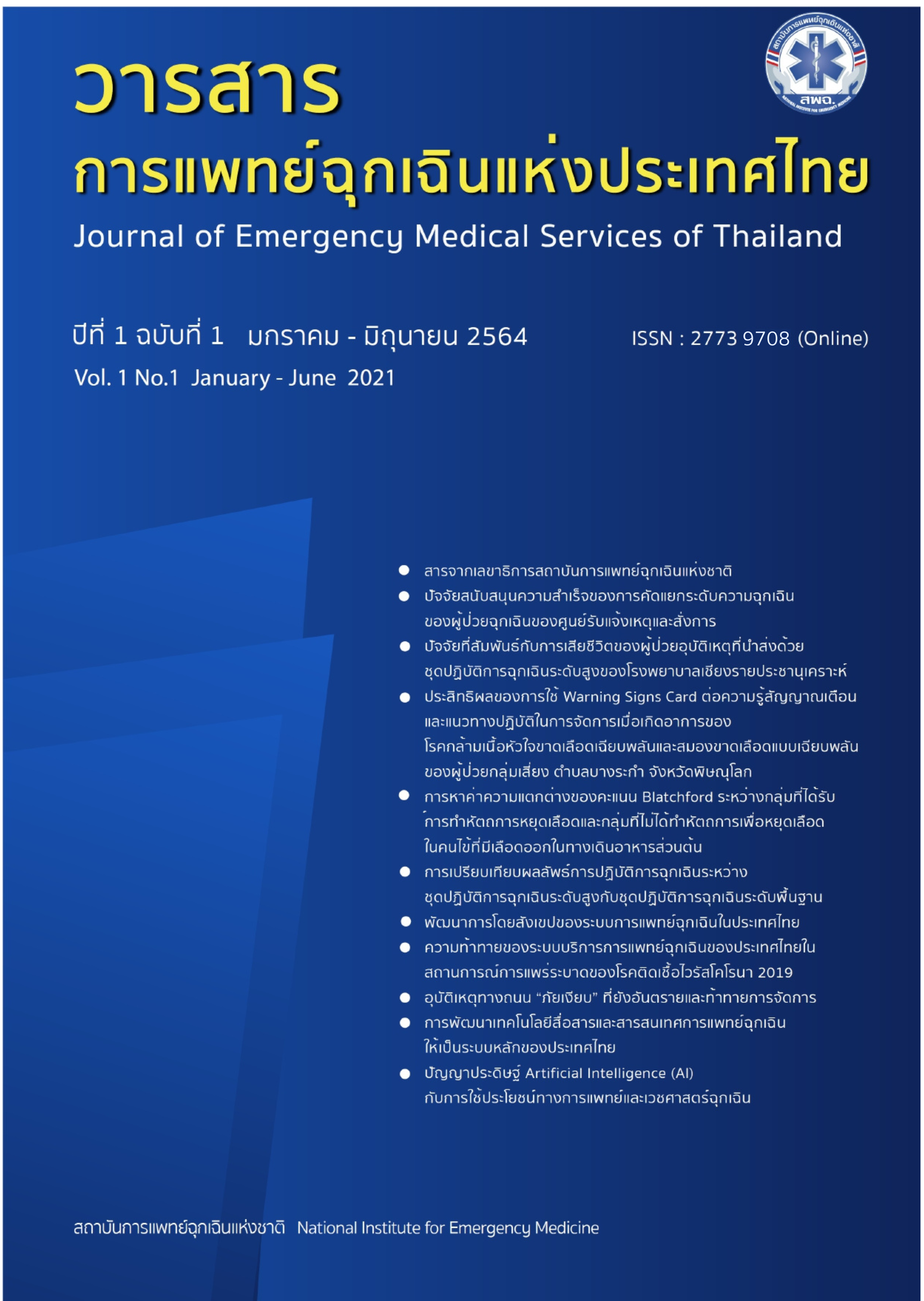ปัญญาประดิษฐ์ Artificial intelligence (AI) กับการใช้ประโยชน์ทางการแพทย์และเวชศาสตร์ฉุกเฉิน
DOI:
https://doi.org/10.14456/jemst.2021.10คำสำคัญ:
ปัญญาประดิษฐ์, การแพทย์ฉุกเฉิน, เวชศาสตร์ฉุกเฉินบทคัดย่อ
ปัญญาประดิษฐ์ (artificial intelligence หรือ AI) คือศาสตร์ที่รวบรวมองค์ความรู้ในหลายสาขาวิชา โดยเฉพาะอย่างยิ่ง ทางด้านวิทยาศาสตร์และวิศวกรรมศาสตร์ มาพัฒนาให้เครื่องจักรหรือระบบคอมพิวเตอร์มีความชาญฉลาด สามารถคิด คำนวณ วิเคราะห์ เรียนรู้และตัดสินใจ โดยใช้เหตุผลได้เสมือนสมองของมนุษย์ และสามารถเรียนรู้ พัฒนา และปรับปรุงกระบวนการทำงานเพื่อเพิ่มศักยภาพของปัญญาประดิษฐ์เองได้ AI ได้รับการพัฒนามาตั้งแต่ ปี พ.ศ. 2493 จนถึงปัจจุบัน จนสามารถนำไปใช้ ประโยชน์ได้ในหลากหลายสาขา รวมถึงสาขาการแพทย์ ซึ่งมีการใช้ AI ในหลายแผนกของโรงพยาบาล ทั้งในแผนกผู้ป่วยนอก แผนกฉุกเฉิน หอผู้ป่วย หอผู้ป่วยวิกฤต ตลอดจนใช้ติดตามประเมินอาการผู้ป่วยทีบ้านผ่านระบบการสื่อสารแบบไร้สาย ซึ่งก่อให้เกิดความปลอดภัย และคุณภาพการบริการที่ดีขึ้น โดยสามารถลดต้นทุนและเพิ่มประสิทธิภาพการบริการทางการแพทย์ เนื่องจากการใช้ AI ก่อให้เกิดความเสี่ยงหลายด้าน ทุกองค์กรจึงควรมีการกำหนดนโยบายการใช้ AI ระบบการจัดการความเสี่ยงที่เกิดขึ้นจากการ ใช้ AI เพื่อป้องกันภาวะไม่พึงประสงค์ที่อาจเกิดขึ้น บทความนี้กล่าวถึงเนื้อหาที่สำคัญของปัญญาประดิษฐ์ ได้แก่ความหมาย พัฒนาการ การใช้ประโยชน์ การใช้ประโยชน์ทางการแพทย์และทางเวชศาสตร์ฉุกเฉิน ข้อจำกัดและประเด็นทางจริยธรรม และ บทสรุปของการใช้ปัญญาประดิษฐ์ทางการแพทย์
เอกสารอ้างอิง
สำนักงานคณะกรรมการดิจิทัลเพื่อเศรษฐกิจและสังคมแห่งชาติ. กระทรวงดิจิทัลเพื่อเศรษฐกิจและสังคม. แนวปฏิบัติจริยธรรมปัญญาประดิษฐ์ Thailand AI Ethics Guideline. กรุงเทพมหานคร: สำนักงานคณะกรรมการดิจิทัลเพื่อ เศรษฐกิจและสังคมแห่งชาติ; 2564.
Wikipedia. Dartmouth workshop [Internet]. 2021 [cited 2021 Apr 28]. Available from: https://en.wikipedia.org/wiki/Dartmouth_workshop.
Lee DH, Yoon SN. Application of artificial intelligence-based technologies in the healthcare industry: opportunities and challenges. Int J Environ Res Public Health 2021; 18: 271.
Silver D, Huang A, Maddison CJ, Guez A, Sifre L, van den Driessche G, et al. Mastering the game of Go with deep neural networks and tree search. Nature 2016; 529: 484-9.
Ellahham S, Ellahham N. Use of artificial intelligence for improving patient flow and healthcare delivery. J Comput Sci Syst Biol 2019; 12: 80-5.
Loh E. Medicine and the rise of the robots: a qualitative review of recent advances of artificial intelligence in health. BMJ Leader 2018; 2: 59–63.
Stewart JE, Rybicki FJ, Dwivedi G. Medical specialties involved in artificial intelligence research: is there a leader? Tasman Medical Journal 2020; 2: 20-7.
Liu N, Lin Z, Cao J, Koh Z, Zhang T, Huang GB, et al. An intelligent scoring system and its application to cardiac arrest prediction. IEEE Transactions on Information Technology in Biomedicine 2012; 16: 1324-31.
Wellner B, Grand J, Canzone E, Coarr M, Brady PW, Simmons J, et al. Predicting unplanned transfers to the intensive care unit: a machine learning approach leveraging diverse clinical elements. JMIR Med Inform 2017; 5: e45.
Échevin D, Li Q, Morin MA. Hospital readmission is highly predictable from deep learning. Québec: Chaire de recherche Industrielle Alliance sur les enjeux économiques des changements démographiques; 2017.
Curtis DW, Pino EJ, Bailey JM, Shih EI, Waterman J, Vinterbo SA, et al. SMART-an integrated wireless system for monitoring unattended patients. J Am Med Inform Assoc 2008; 15: 44-53.
Liu N, Koh ZX, Chua ECP, Tan LML, Lin Z, Mirza B, et al. Risk scoring for prediction of acute cardiac complications from imbalanced clinical data. IEEE Journal of Biomedical and Health Informatics 2014; 18: 1894- 902.
Berlyand Y, Raja AS, Dorner SC, Prabhakar AM, Sonis JD, Gottumukkala RV, et al. How artificial intelligence could transform emergency department operations. Am J Emerg Med 2018; 36: 1515-7.
Tenhunen H, Hirvonen P, Linna M, Halminen O, Hörhammer I. Intelligent patient flow management system at a primary healthcare center-the effect on service use and costs. Stud Health Technol Inform 2018; 255: 142-6.
Jones SS, Thomas A, Evans RS, Welch SJ, Haug PJ, Snow GL, et al. Forecasting daily patient volumes in the emergency department. Acad Emerg Med. 2008; 15: 159-70.
Marcilio I, Hajat S, Gouveia N. Forecasting daily emergency department visits using calendar variables and ambient temperature readings. Acad Emerg Med 2013; 20: 769-77.
คณะแพทยศาสตร์ สถาบันเทคโนโลยีพระจอมเกล้าเจ้าคุณทหารลาดกระบัง. AIEMS คัดกรองผู้ป่วยฉุกเฉิน [อินเทอร์เน็ต]. 2562 [สืบค้นเมื่อ 1 มิ.ย. 2564]. แหล่ง ข้อมูล: https://www.kmitl.ac.th/th/detail/2019-12-18-16-09-24
Savatmongkorngul S, Yuksen C,Suwattanasilp C, Sawanyawisuth K, Sittichanbuncha Y. Is a mobile emergency severity index (ESI) triage better than the paper ESI?. Intern Emerg Med 2017; 12: 1273-7.
ยุวเรศมคฐ์ สิทธิชาญบัญชา. การพัฒนาคุณภาพการคัดแยกจากทฤษฎีสู่การปฏิบัติ. ใน: ยุวเรศมคฐ์ สิทธิชาญบัญชา, บรรณาธิการ. การพัฒนาคุณภาพแผนกฉุกเฉินจากทฤษฎีสู่การปฏิบัติ. พิมพ์ครั้งที่ 1. กรุงเทพมหานคร: ปัญญมิตร การพิมพ์; 2561. หน้า 101-10.
Bernazzani S. 10 jobs artificial intelligence will replace (and 10 that are safe) [Internet]. 2019 [cited 2021 Apr 28]. Available from: https://blog.hubspot.com/marketing/jobs-artificial-intelligence-will-replace
Pink D. A whole new mind [Internet]. 2021 [cited 2021 Apr 28]. Available from: https://www.catalystreview.net/a-whole-new-mind/
ดาวน์โหลด
เผยแพร่แล้ว
รูปแบบการอ้างอิง
ฉบับ
ประเภทบทความ
สัญญาอนุญาต
ลิขสิทธิ์ (c) 2021 สถาบันการแพทย์ฉุกเฉินแห่งชาติ

อนุญาตภายใต้เงื่อนไข Creative Commons Attribution-NonCommercial-NoDerivatives 4.0 International License.






